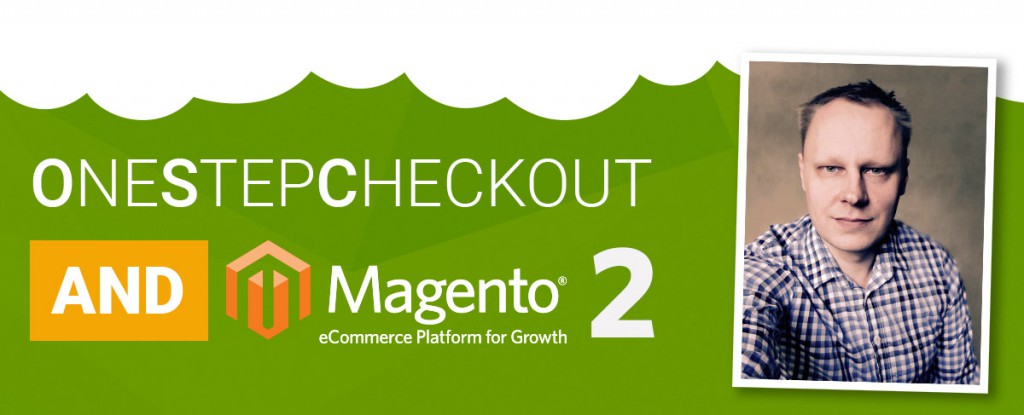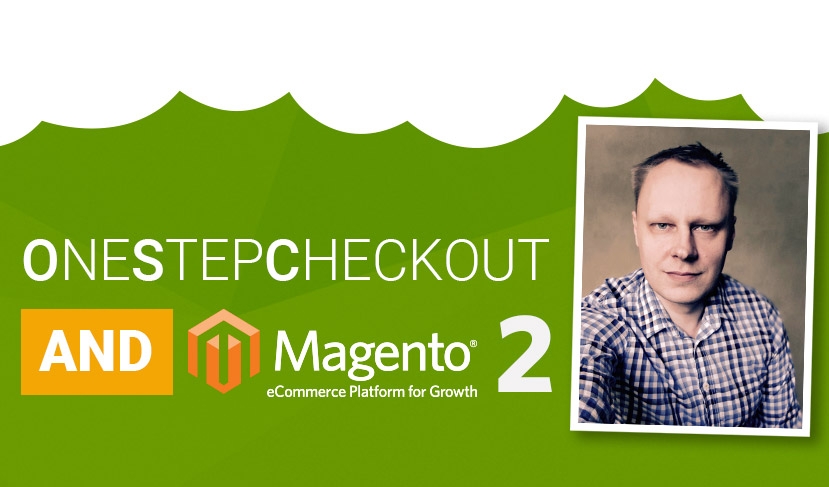Hi everyone
Here is an interview of Anton Siniorg, our lead developer, where he explains in fairly simple terms what Magento 2.0 is about and what it means for the checkout function of online businesses.

TL: Hi Anton, tell us a bit about yourself:
AS: I have been with OneStepCheckout from its early versions managing support, ongoing maintenance and the development of the extension.
We grew together with the whole Magento ecosystem, witnessing increasing adoption of the platform and evolution of features. That allowed us to very quickly reach thousands of clients all around the world. Over my five years at OneStepCheckout I’ve helped those clients reach their checkout goals and I have seen and learnt a lot, solved a lot of issues and had an opportunity to debug every possible Magento related issue.
Great thing with software is that it brings together a wide variety of people around the world. I was born and still live in Estonia and although it is a small place, a lot of IT innovation happens here.
TL: How did you become a developer?

An issue 2 1982 ZX Spectrum
(Photo: Bill Bertram – Own work, CC BY-SA 2.5)
AS: IT has been fascinating me since I was a kid. I have been dealing with web and e-com development over 18 years now. It was fun to grow with IT as when we were young, IT was very different and we were able to follow the great progress from ZX Spectrum (that you could program and save programs to tape). It was the era before the Internet hit the world and today every kid has a tablet in his pocket.
For me it took a serious turn while I was studying physics at university and suddenly had access to all modern resources. It blinded me and I used all my available time to play with programs, computers and learn the essentials. I ditched physics at some point when it was clear to me that I wouldn’t be a second Einstein, switched lanes and committed to law studies.
Then I got a position in a small IT company and started making websites (Netscape 3 was the most popular browser at this time). Seeing the trouble our clients had in both the legal and technical aspects trying to introduce e-commerce to their businesses, lead me to deal with all kinds of e-commerce platforms and services.
Even after I got my degree in law it was obvious for me that development and IT projects are the thing I like the most.
It all changed when Magento gained more popularity. Finally merchants had a more stable platform to support their e-commerce ventures and this platform was used all around the world. This was great for merchants as they could now hire experts from different parts of the world. Gone was the era were closed platforms locked merchants to certain vendors and no other team could to take over the site to develop it further or even provide simple support.
I instantly saw the opportunity, taught myself the Magento framework and learnt how to build extensions for it. Since this was the early days I got a lot of possibilities to play with the platform to solve any imaginable form of issues our clients had: migrate an old site to Magento, transform databases, integrate ERPs, whatever inventory systems they used, solve the bugs in platform and whatever the next challenge was. Looking for more global projects I found OneStepCheckout who offered me the opportunity to deal with an even greater variety of issues and clients around the world.
TL: What are your thoughts about Magento 2.0?
AS: With Magento 2.0, the community of merchants and developers enter a new era of possibilities. The platform has matured, it is no longer just a blind race for features and bug fixes. It’s more about stability and controlled growth. It’s not all flowers and peaches though as lot of learning is involved for both merchants and developers before they can get the benefits out of it.
Some see this as a new start for their businesses, a stable platform to begin with, some see the pain of managing the migration to support their existing businesses: technical hurdles, the pain of learning, the pain of making the same mistakes all over again.
The new platform has lot of advantages and brings a cleaner structure and well tested patterns and frameworks, it embraces new development processes and automation.
This version actually thinks about developers and is easier to manage than ever. But the flipside is that the community also has to raise the bar in terms of knowledge and skills, to manage the codebases, be more efficient and give more attention to code quality.
We have followed the Magento 2.0 evolution closely and we already see the potential to support merchant long-term platform strategies, both in terms of features it offers and in terms of maintaining a codebase, technical aspects.
As Magento 1 support will be phased out within 3 years, I strongly suggest to merchants out there to plan their next steps and evaluate Magento 2.0.
TL: How is native checkout changing with Magento 2.0?
AS: Magento 2.0 also changes the default experience on checkout. It is now cleaner and better structured but still hides a lot of information at first. So we can say that it changes and at the same time it does not change. The overall logic is the same and mostly UI and UX are different.
Checkout is critical part of any e-commerce site – where actual deal closing takes place – getting this right is very important for every merchant. My opinion is that even with Magento 2.0, checkout still needs a separate evaluation and measurement based on your e-commerce strategy.
You can’t just depend on defaults and there is a lot of room for improvement
 TL: What value is OneStepCheckout adding?
TL: What value is OneStepCheckout adding?
AS: OneStepCheckout brings a different approach and tries to solve some pain points both for end-users and for merchants: shopping carts abandonment.
OneStepCheckout gives an overview of all related or possible costs at a glance. It makes it easier for online shoppers to fill out the form and displays updated totals each time shoppers want to change a parameter. By giving optimal choices for the shopper, merchants are valuing their customers’ time and shorten the path to order completion leading to increasing their sales conversion.
For merchants in different regions, checkout is a mix of costly problems. Starting from legal frameworks and data they need to record, to shipping agreements, payment gateways available in their region and all other functionalities or extensions they need to bring to this one important page. OneStepCheckout is the expert at solving these issues as we’ve been doing it for over 19,000 merchants over the last 6 years. We spend a lot of time integrating 3rd party extensions to make it work smoothly across the whole Magento ecosystem.
Together with Magento 2.0 we have built the new OneStepCheckout to respect all those aspects and restructured our codebase to support the new architecture from ground up while maintaining the ease of extending and adapting the extension to different checkout experience for different regions. With OneStepCheckout for Magento 2.0, we have set ourselves new goals on both usability for clients, developers and merchants.
TL: Why didn’t Magento build it in their native checkout?
AS: While obviously Magento team has the skills and resources to solve every little detail in some specific niche, the intent of Magento 2.0 is still to provide a strong platform for merchants to evolve with and build their business on. Dealing with the specificities of checkout in each region as well as the variety of extensions is just too broad and complex. This leaves room for the community to offer specialized services at all levels and that’s where we developed our expertise. Day in day out, all we do is to focus on checkout for Magento stores. We expect to learn very quickly from our experience building the best checkout process for Magento 2.0 and we will help enrich the documentation available to the community in this field.
TL: What is your piece of advice to Magento store owners out there?
AS: My first advice is to take the time to think about how Magento 2.0 can really serve your needs as a merchant in the long term. Although time is always short, we as merchants, developers and clients need to look at the bigger picture. Software is too complex and it’s easy to get lost in details, so I’d suggest for merchants to focus more on how to manage the process as whole. General knowledge on “code owning”, agile project management, why deployment should be automated, would allow a merchant to position themselves towards developers and better define their business needs. As a merchant you don’t have to know how to do everything yourself but you need to create a clear vision of what your business objectives are and find the best resources to get there.
As far as checkout is concerned you can trust us to handle all the complexity to make it work the way you want, beautifully.
TL: Thien-Lan Weber
AS: Anton Siniorg
